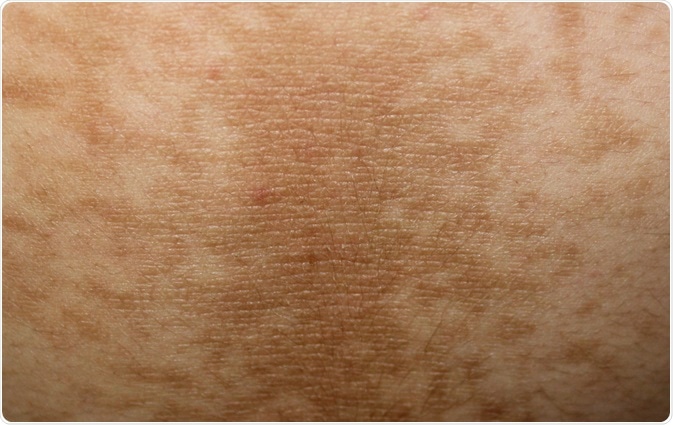Acanthosis nigrincans is hyperpigmentation and hyperkeratosis of the skin, which may be indicative of an underlying health condition. It usually affects specific areas of the body in folds of skin, such as in the armpit, the groin, and the back of the neck.
Acanthosis can either be benign or malignant. The malignant type is the classic type, although this is rare and most cases are classified as benign, sometimes referred to as psuedoacanthosis nigricans.
 Image Credit: Dermatology11 / Shutterstock.com
Image Credit: Dermatology11 / Shutterstock.com
Causes of acanthosis nigricans
The exact pathogenesis of acanthosis nigricans is not clear, although there are several risk factors that are associated with the disorder. These include:
- Obesity and insulin resistance
- Syndromes: high levels of insulin, Cushing syndrome, polycystic ovary syndrome, abnormal lipid levels
- Medications: nicotinic acid, insulin, systemic corticosteroids, hormonal therapy
- Genetics: inheritance of autosomal dominant trait from parents
- Cancer: Stomach and other types of cancer may lead to presentation of symptoms
Signs and symptoms of acanthosis nigricans
The characteristic sign of acanthosis nigricans is patches of skin that become thicker, darker in color and develop a velvety texture. Although the patches can affect any area of the body, they most commonly affect folds of skin, such as the armpit, the groin, or the back of the neck. It may also affect the elbows, the knees, and underneath breasts.
Other features of the skin disorder may include:
- Papillomatosis on cutaneous and mucosal surfaces
- Pruritus or itching
Lesions may also present on the mucus membranes of the mouth, nose, larynx, and esophagus. These tend to be more severe in patients with the malignant form of the condition.
Diagnosis of acanthosis nigricans
A crucial step in the diagnostic process of acanthosis nigricans is to differentiate the malignant cases from the benign cases. Malignant tumors are usually more aggressive, with a sudden onset and fast progression of symptoms.
Other causes of acanthosis, such as obesity or insulin resistance, can be identified with the appropriate testing.
Therefore, a complete medical history, including family history of similar symptoms, and physical examination is usually carried out to determine the risk of possible causes. The specific tests ordered from this point will depend on the individual case scenario.
Treatment of acanthosis nigricans
The aim of acanthosis nigricans treatment is to establish and manage the underlying cause of disease in an appropriate manner. The changes to the skin in itself is not usually a significant threat to health, but can be an indicator of underlying conditions that require early intervention for the best outcomes.
In some cases, particularly for patients with acanthosis nigricans associated with obesity, diet lifestyle changes may be sufficient to address the problem. Opting for healthier dietary choices and participating in regular physical activity is important for weight loss and lifestyle management.
For patients with acanthosis nigricans caused by an inherited genetic factor, the condition usually stabilizes or regresses spontaneously without treatment. Therefore, treatment is not usually required.
If the use of a certain medication is likely to be linked to causing the condition, the offender should be ceased or tapered off, depending on the drug.
If a tumor has been identified in the diagnostic process, this may need to be surgically removed and further treated with chemotherapy or radiotherapy, depending on the particular case.
Some individuals may be concerned about the cosmetic appearance of the skin affected by acanthosis nigricans. In this case, there are several therapeutic options that may offer a benefit to reduce the signs of the disorder on the skin. Examples of possible therapies include topical retinoid medications, dermabrasion, and laser therapy.
Acanthosis Nigricans
References
Further Reading